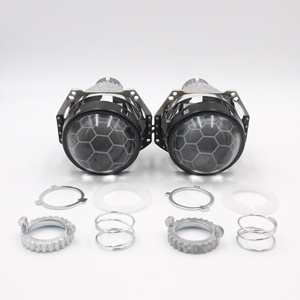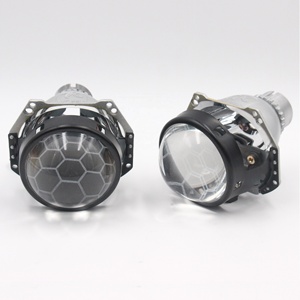
All categories
Featured selections
Trade Assurance
Buyer Central
Help Center
Get the app
Become a supplier

(1609 products available)

















































Single Beam D2S Bi-Xenon Projector
Generally, D2S projectors are used as low-beam lights. They provide a focused light beam that is not blinding to other road users. The D2S Bi-Xenon projectors have two separate light sources. The D2S projectors generate a low beam that is perfect for driving on back roads. When extra light is needed, the second light source generates a high beam. This combination makes the D2S Bi-Xenon projector ideal for various driving environments.
Dual Beam D2S Bi-Xenon Projector
This type of projector uses one bulb to generate both the low and high beams. The D2S Bi-Xenon dual beam projectors are more compact than the single beam projectors. They are designed to be used in vehicles that have less room for the headlight assembly. When the D2S Bi-Xenon dual beam projector is activated, the bulb ignites to produce a bright white light. A shutter system inside the projector quickly switches between the low and high beams without needing a second bulb. This mechanism is efficient and saves energy.
D2S Bi-Xenon Projector Lens Size
The lenses of the D2S Bi-Xenon projectors come in different sizes. They range from 2.5 to 3.0 inches in diameter. The size of the lens affects how light is distributed. Larger lenses offer a more focused light beam with a longer throw distance. They are suitable for driving at high speeds. Smaller projectors provide a wider beam pattern. The choice of lens size depends on individual preferences and driving conditions.
1. Regular Cleaning
Clean the projector lens and housing to remove dirt, dust, and debris regularly. Use a soft microfiber cloth and gentle cleanser for this. Avoid abrasive materials that might scratch the lens.
2. Check Bulbs
Inspect the xenon bulbs for any signs of discoloration or dimming. Replace bulbs in pairs to maintain uniform brightness and avoid uneven light output.
3. Tighten Connections
Check all electrical connections, including those to the ballast and ignitor. Tighten any loose connections to prevent flickering or bulb failure.
4. Inspect Ballast
Check the ballast for any signs of damage or moisture exposure. Replace a faulty ballast to guarantee reliable bulb ignition.
5. Adjust Shutters
Ensure the bi-xenon shutters are functioning properly. Adjust them as necessary to obtain correct low and high beam positions.
6. Lens Alignment
Check that the projector lenses are correctly aligned. Misalignment might result in uneven light distribution. Align the lenses as necessary.
7. Reflector Inspection
Inspect the reflectors for corrosion or wear. Replace reflectors as needed to optimize light focusing.
8. Electrical System Check
Check the vehicle's electrical system. Ensure it can handle the additional load of the bi-xenon projectors.
9. Professional Maintenance
Consider professional maintenance for complex issues or projector modifications. Technicians have the expertise and tools to troubleshoot and repair problems.
10. User Manual Reference
Refer to the manufacturer's user manual for maintenance recommendations and specifications. Follow the suggested maintenance schedule for maximum projector performance and lifespan.
When sourcing D2S Bi-xenon projectors, it's essential to understand the various factors that affect the quality and performance of this car headlight. Below are some of the most important ones:
The Lens
The lens of a D2S Bi-xenon projector is a critical component that affects visibility. It is made from high-quality glass or polycarbonate material. Glass lenses are more durable and scratch-resistant than polycarbonate ones. On the flip side, polycarbonate lenses have a higher impact resistance. The thickness and curvature of the lens also affect the projection of light. Thicker lenses provide better focus and clarity, while curved lenses offer a wider viewing angle.
The Bulb
The bulb of a D2S Bi-xenon projector is another crucial factor to consider. These bulbs produce bright white light with excellent color accuracy. Their brightness level is measured in lumens, with higher lumen counts indicating brighter light. The wattage of the bulb also affects brightness, with higher wattages producing more light. D2S Bi-xenon bulbs come in various color temperatures, ranging from cool white to daylight white. Choose a color temperature that matches the needs of the target customers.
The Housing
The housing of a D2S Bi-xenon projector is designed to protect the lens, bulb, and other components from the environment. Opt for projectors with housing made from sturdy materials like aluminum or stainless steel because they are more resistant to corrosion and wear. The housing should also be waterproof and dustproof to prevent damage from moisture and debris. Consider the size and shape of the housing, as it needs to fit perfectly in the vehicle's headlight assembly.
Shutter Mechanism
The shutter mechanism controls the high and low beam functions of the D2S Bi-xenon projector. A well-designed shutter ensures a smooth and quick transition between beam modes. The shutter is usually made from durable materials like stainless steel or high-temperature plastic. The shutter's size and shape also affect beam patterns and coverage.
Ballast and Ignitor
The ballast and ignitor are essential components of the D2S Bi-xenon projector system. The ballast regulates the power supplied to the bulb, ensuring a stable and efficient operation. Look for projectors with high-quality ballasts that are compatible with the vehicle's electrical system. The ignitor provides the initial spark to ignite the gas inside the bulb. Choose projectors with reliable ignitors that ensure a quick and consistent ignition of the xenon gas.
Beam Pattern
The beam pattern of the D2S Bi-xenon projector affects how the light is distributed on the road. Different projectors offer various beam patterns, such as spot, flood, or a combination of both. A spot beam pattern focuses the light into a narrow, long-range beam. In contrast, a flood beam pattern distributes the light wider but shorter. Choose a beam pattern that matches the target customers' preferences and driving conditions.
Replacing D2s bi-xenon projectors can be a DIY-friendly task. To do it, follow the steps below:
1. Gather the needed materials
one will need to get the right d2s bi-xenon projectors for their vehicle. Also, get a screwdriver set, safety glasses, and gloves.
2. Prepare the vehicle
turn off the vehicle and open the hood. Disconnect the battery, mainly the negative terminal, to avoid electrical damage when working with the vehicle's electrical components.
3. Remove the front grill
depending on the vehicle model, one may need to remove the front grill to access the headlight assembly. The grill may be held in place with screws or clips.
4. Take out the headlight assembly
locate the screws holding the headlight in place and remove them. After that, carefully pull out the headlight assembly from the vehicle.
5. Take out the old D2s bi-xenon projectors
open the headlight assembly and locate the old d2s bi-xenon projectors. Unscrew the screws holding the projectors in place and carefully take them out. Also, disconnect the electrical connections.
6. Install the new D2s bi-xenon projectors
take the new d2s bi-xenon projectors and connect their electrical connections. Then, carefully place them inside the headlight assembly and secure them with screws.
7. Reassemble everything
close the headlight assembly and put it back in place. Reattach the front grill and ensure everything is in its right place. Then, reconnect the vehicle's battery, mainly the negative terminal, and ensure all the connections are secure.
Q1: Can one install D2S bi-xenon projectors in any car?
A1: One can install D2S bi-xenon projectors in any car, but it requires proper retrofitting and compatibility considerations. Some vehicles need additional modifications to accommodate the projectors.
Q2: What is the lifespan of D2S Bi-Xenon bulbs?
A2: The D2S Bi-Xenon bulbs have a lifespan of about 2000 hours. However, with proper care and usage, they can last longer.
Q3: Do D2S bi-xenon projectors require special ballasts?
A3: Yes, the D2S bi-xenon projectors require special electronic ballasts. They are used to ignite and stabilize the xenon gas in the bulbs.
Q4: Can one get D2S bi-xenon projectors with adjustable focus?
A4: Yes, they are available. The D2S bi-xenon projectors with adjustable focus allow users to set the beam intensity and focus according to their preferences.
Q5: Are D2S bi-xenon projectors suitable for off-road vehicles?
A5: Yes, the D2S bi-xenon projectors are suitable for off-road vehicles. They offer excellent illumination in low-light conditions, which is beneficial for off-road driving.